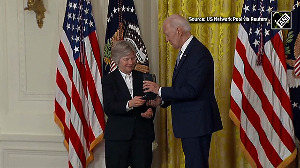The state governments now have more money than ever before. How is this influencing their spending?

Photograph: Reuters
Are new ways of doing business, such as e-commerce, also creating new revenue streams?
Is higher social sector spending only a re-election route or an acknowledgement that good economics is also good politics?
Ishan Bakshi studies the Budgets of six states, their expenditure priorities and outlays to understand the trend.
Bihar: Broke but more educated
Bihar always had little money. What it had was reduced further after the decision to ban country liquor, after the Nitish Kumar-Lalu Prasad government came to power in 2015.
As a result, it is more dependent than other states on central transfers to fund expenditure.
In 2016-17, the state expects to receive 58,359 crore as its share in central taxes, up from 50,747 crore in 2015-16 and 36,963 crore in 2014-15.
Equal to 10.4 per cent of the gross state domestic product (GSDP) in 2016-17.
Taken together, transfers from the central government, including grants in aid, account for roughly three-fourths of the state's total revenue receipts.
Bihar's own tax collections account for less than a fourth of that total. It expects own tax revenue to grow 16 per cent in 2016-17 but this might be an overestimate.
The state has not introduced any new taxes in the Budget and will lose 4,000 crore in excise duty collections after the ban on country liquor from April.
Its own tax revenue is expected to decline to 5.3 per cent of GSDP in 2016-17.
On the expenditure side, education remains a top priority, with the Budget allocating 10,950 crore or 15.3 per cent of the total plan outlay for this.
The power sector has also seen an increase, with the government proposing to provide an electricity connection to every household.
The Budget has allocated, 9,658 crore or 13.5 per cent of the total plan outlay to this sector.
In 2015-16, the state had ramped up social sector spending on account of Assembly elections.
As a consequence, the fiscal deficit rose from a budgeted 13,584 crore in 2015-16 to 28,505 crore the same year.
Spending is now expected to be curtailed, to bring the deficit to 16,014 crore.

West Bengal: More human investment
With the state gearing up for elections, the government has increased spending on the social sector, from 51,532 crore in 2015-16 to 62,528 crore in 2016-17.
As a percentage of expenditure, spending here has increased to 39.2 in 2016-17 from 35.5 per cent in 2015-16.
Social sector spending now outstrips that on general services.
As a consequence, spending on economic services has been squeezed, from 24.7 per cent in 2015-16 to 20.9 per cent in 2016-17 of total expenditure.
The state now spends roughly half on economic services as compared to the social sector.
Finance Minister Amit Mitra claims the state had set a record in expenditure on the social sector, by increasing rural development budget by four times and the health budget by three times.
He has tripled the agricultural budget and planned expenditure for women and child welfare.
To fund this, the state is relying more on transfers from the central government.
After the 14th Finance Commission (FFC), its share in central taxes as a percentage of its GSDP has gone up from 3.5 per cent in 2015-16 to four per cent in 2016-17 (both Budget Estimates or BE).
Own tax revenue is projected to grow 17 per cent in 2016-17, after 33 per cent in 2015-16. Given the elections, there are no new taxes in the Budget.

Madhya Pradesh: E-commerce awakening
After the increase in tax devolution, the state's share in central taxes increased to Rs 43,676 crore in 2016-17, up from Rs 39,705 crore in 2015-16 and 24,106 crore in 2014-15.
This is a third of total revenue receipts, up from five per cent of GSDP in 2015-16 to 6.1 per cent in 2016-17.
The state expects own tax revenue to grow 13.6 per cent, up from 11.8 per cent in 2015-16.
For this, it has proposed a six per cent tax on goods purchased online when these enter the state.
Though the details of this are sketchy, according to news reports, the government plans to collect details of goods through courier companies. There's also a hefty increase in value-added tax (VAT) on plastic products.
Offset by a proposal to remove five per cent VAT on battery operated cars and rickshaws.
The government says capital expenditure would rise from 37.6 per cent of total expenditure in 2014-15 to 46.9 per cent in 2016-17. It had declined 1.8 per cent, from 24,713 crore in 2014-15 to 21,954 crore in 2015-16.
The state proposes to spend 452 crore on Metro Rail projects for Indore and Bhopal.
Another 4,305 crore is for construction and maintenance of roads and bridges.
Moreover, 400 crore has been allocated for the Pradhan Mantri Awas Yojana, which aims to provide housing for all. Machines used for making bio fertilisers and for milk processing are proposed to be freed of tax.

Jharkhand: More than mining
The FFC award has added to the wealth of this mineral-rich state, with a sharp increase in transfers from the central government.
The share in central taxes was budgeted to go up from Rs 9,487 crore in 2014-15 to Rs 12,000 crore in 2015-16; it actually went up to Rs 16,499 crore. In 2016-17, it is estimated to be 7.1 per cent of GSDP, up from 5.3 per cent in 2015-16 (BE).
Own-tax revenue is budgeted to grow 20 per cent in 2016-17. This might seem optimistic but it had grown 38 per cent in 2015-16.
The state has not announced any new taxes but has proposed ways to simplify the tax processes and curb evasion.
Capital spending rose from 20.6 per cent of total expenditure in 2014-15 to 23.2 per cent in 2016-17.
One reason for the latter's rise is the Ujwal Discom Assurance Yojana scheme to relieve state power distribution companies from debt.
While spending on the social sector is down as a proportion of the total, it has increased allocation to agriculture and rural development.
In terms of share, there has been a marginal drop in education and public health.
The Budget has earmarked 15.3 per cent of total spending for education, art, culture and sports.
And, 13.8 per cent for rural development, nine per cent for agriculture and allied activities. Plus 9.8 per cent on social security and 3.5 per cent for urban development.
 Andhra Pradesh: Investing in education
Andhra Pradesh: Investing in education
Despite the task of building the new capital city of Amaravati, the Chandrababu Naidu government has about doubled spending on the social sector in its latest Budget.
As against 10,545 crore in 2015-16, the government has projected Rs 21,556 crore in 2016-17.
On both agriculture & allied activities and irrigation, it proposes to spend less than what was actually spent in 2015-16.
Spending on agriculture and rural development is budgeted at Rs 13,648 crore, down from Rs 15,865 crore in 2015-16.
That on irrigation is budgeted at Rs 7,325 crore, from Rs 8,326 crore in 2015-16.
Past trends, though, suggest more will be spent than was budgeted. In 2015-16, actual spending on these sectors was 60 per cent higher than originally budgeted.
Allocations to social sector schemes include roughly Rs 3,000 crore for social security pensions, Rs 4,000 crore for farm loan waivers and Rs 2,700 crore for the public distribution system.
To build the new capital city, the government has provided Rs 1,500 crore.
This will be used as seed equity to help the Capital Region Development Authority mobilise the additional resources required.
To fund the massive expansion in its expenditure, the state is relying in equal measure on own tax revenues and transfers from the Centre.
It hopes to mop 48 per cent of total revenue receipts through its own tax base, with 47 per cent through central transfers - Rs 24,637 crore via its share in central taxes and Rs 26,849 crore as grants.

Chhattisgarh: Capex stays a priority
Chhattisgarh has seen a sharp decline in the contribution of own tax revenue to total revenue receipts.
The former is projected to grow only 1.8 per cent in 2016-17, after 37 per cent in 2015-16.
As a consequence, own tax revenue is projected to decline from 7.8 per cent of GSDP in 2016-17, from 8.6 per cent in 2015-16.
In the FFC's aftermath, the state's share in the divisible pool more than doubled, from Rs 8,363 crore in 2014-15 to Rs 16,213 crore in 2015-16.
In 2016-17, transfers from the Centre are budgeted at roughly 30 per cent of total revenue receipts.
The state has steadily increased capital expenditure. Government spending on capex as a percentage of total expenditure is projected to grow from 14.3 per cent in 2014-15 to 18.6 per cent in 2016-17.
The budget has set aside Rs 4,640 crore for construction of bridges, 56 per cent more than last year.
Presenting the budget, Raman Singh, the chief minister, who also holds the finance portfolio, said special focus was being given to the agricultural sector.
Drought-hit farmers are to get Rs 540 crore, with another Rs 150 crore for free seeds to paddy farmers and Rs 8 crore for the marriage of drought-hit farmers' daughters, under the Mukhya Mantri Kanya Vivah Yojana. Allocation for farm insurance rises from Rs 50 crore to Rs 200 crore.
With the government hoping to increase irrigation facilities on 83,000 hectares in the coming years, Rs 2,574 crore has been allocated for its development. And, Rs 700 crore for the Prime Minister's Swachh Bharat Abhiyan.











 © 2025 Rediff.com -
© 2025 Rediff.com -